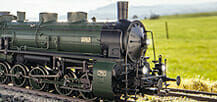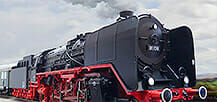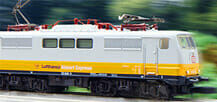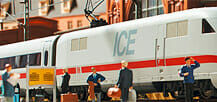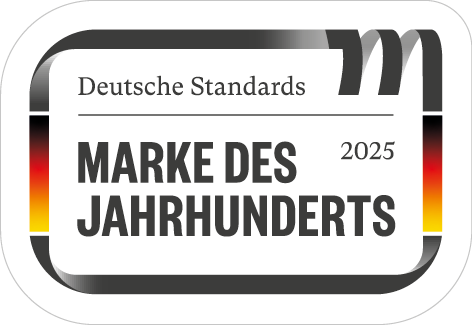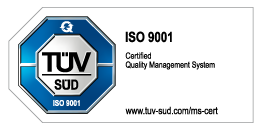Class V 100.20 Diesel Locomotive
Prototype: German Federal Railroad (DB) class V 100.20 diesel locomotive. Crimson red version for Era III. The locomotive looks as it did around 1965. Road number V 100 2263.
Most Important Facts
Sound demo| Article No. | 37008 |
|---|---|
| Gauge / Design type | H0 / 1:87 |
| Era | III |
| Kind | Diesel Locomotives |
Check with your local dealer Now available via speciality dealer. This exclusive article is not available in our online shop, instead you can purchased them from specific retailers. Please contact your local retailer. Find Dealer
Highlights
- mfx+ digital decoder.
- Extensive sound functions.
- Telex couplers.
-
Product description
Model: The locomotive has an mfx+ digital decoder and extensive sound functions. It also has controlled high-efficiency propulsion with a flywheel, centrally mounted. All 4 axles powered by means of cardan shafts. Traction tires. The locomotive has Telex couplers front and rear that can be controlled separately. The triple headlights and dual red marker lights change over with the direction of travel, will work in conventional operation, and can be controlled digitally. Warm white and red LEDs are used for the lighting. The locomotive has detailed buffer beams. Brake hoses that can be plugged into the end of the locomotive are included.
Length over the buffers 14.1 cm / 5-9/16".A freight car set with 4 cars to go with this locomotive is being offered exclusively for the MHI under item number 45082.
Find more Märklin explanation videos on our YouTube Channel
Spare parts for our articles can be found here in our spare parts search.
One-time series.
-
Publications
- New items brochure 2017 - Product programme 2017/2018
-
Prototype information
The class V 100 diesel locomotives were developed in the Fifties initially as a replacement for the class 64 and 86 steam locomotives and the former were planned for light service on main lines and mixed use on branch lines. The V 80 served as a prototype, but the new locomotive was to be considerably more cost effective. MaK in Kiel was contracted to develop this locomotive in cooperation with the DB's central office in Munich. Late in the fall of 1958 MaK delivered five pre-production locomotives, road numbers V 100 001-005 (later V 100 1001-1005, and from 1968 on 211 001-005) with 1,100 horsepower motors as well as road number V 100 006 (later V 100 2001, and from 1968 on 212 001) which had been equipped with a 1,350 horsepower motor. In 1961/62, an order was placed for 20 pre-production locomotives of the class V 100.20 with the more powerful 1,350 horsepower motor as a "lightweight main line locomotive". Between 1963 and 1966, the German locomotive builders delivered two groups of totaling 360 units of this more powerful variation. In 1965 ten units (road numbers V 100 2332-2341) from the latter series were equipped with hydrodynamic brakes for use on the steeply graded route from Rastatt to Freudenstadt. The squared off, boxy shape was characteristic for the V 100 and clearly borrowed from the V 60 for this look. The motor output was transmitted to the hydraulic Voith transmission by means of an elastic coupling and universal joint shaft. The transmission had stepped gears allowing operation on the line (maximum speed 100 km/h / 63 mph) or in switching operations (maximum speed 65 km/h / 41mph). The trucks with their tube construction were a new design, and the wheel set suspension arms were mounted on them by means of silent blocks. The engine layout in the front, longer hood was very accessible from outside by means of a hood-shaped sliding door. These units were general-purpose locomotives and were run with light and medium passenger, fast passenger, and freight trains on main lines and branch lines. In 1968, the V 100.20 was assigned the computer-generated class designation of 212; the locomotives for steeply graded routes were run as the class 213. From the mid-Nineties on these locomotives were used less and less. The last units were taken out of service on the DB AG's freight division (Railion) in December of 2004. These retired locomotives were not scrapped for the most part; most were sold via locomotive dealers. Many are used today by track construction firms in France and Italy. Private German railroads and foreign state railroads were and still are willing buyers of the V 100.20 (212). Even the DB has not dispensed entirely with these proven locomotives. Twelve re-motored units are in operation on the DB Fahrzeugdienste GmbH (locomotive and car maintenance unit of the DB) and six of the 212/213 can be found at the DB Bahnbau-Gruppe GmbH (track maintenance unit of the DB). Fifteen units remain available rebuilt as the class 714 for the DB Netz Notfalltechnik (network emergency technology unit of the DB) and serve as motive power for rescue trains that are used chiefly for emergencies on the newly constructed routes.
-
Digital Functions
Control Unit Mobile Station Mobile Station 2 Central Station 1/2 Central Station 3/2*
Mobile Station 2**Headlight(s) Telex coupler on the front Diesel locomotive op. sounds High Pitch Horn Telex coupler on the rear Direct control Headlight(s): Cab2 End Low Pitch Horn Headlight(s): Cab1 End Sound of squealing brakes off Letting off Air Conductor's Whistle Switching maneuver Sound of Couplers Engaging Coupler procedure for uncoupling Operating sounds * New features of the Central Station 2 (Part No. 60213, 60214 or 60215) with the software update 4.2
** New features of the Mobile Station 2 (Part No. 60657/66955) with the Software Update 3.55
